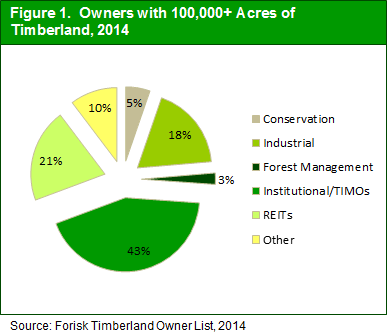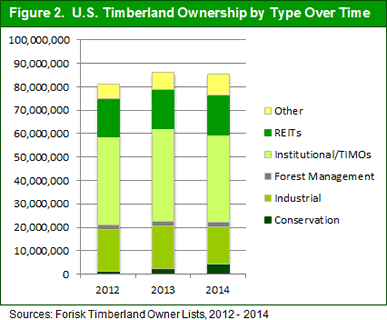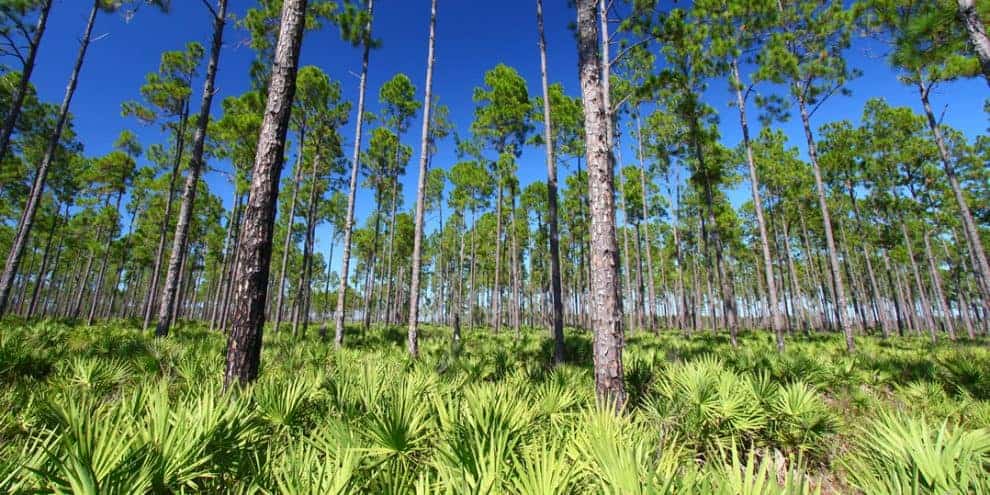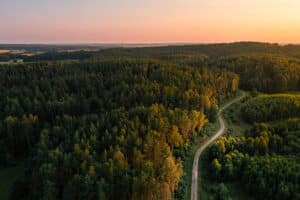In the United States, “industrial” timberlands – those acres owned and managed with a primary objective of generating more wood volume and cash flows in less time than publicly or other privately owned forests – comprise 8% to 14% of all U.S. forests. Since 2010, Forisk has tracked timberland ownership to support its forestry investment research and study of timberland investment vehicles. In the past twelve months, our team made 195 updates to the annual Timberland Owner List, including 103 updates associated with acres owned and managed. The 2014 Timberland Owner List includes 302 organizations with average ownership of 305,188 acres in the U.S. This article includes summary data and findings from this research.
Timberland Owner Types
 In the United States, industrial timberland ownership and management skews strongly to larger firms. Economies of scale and the significant resources required for operations drive this reality. Of the 92.2 million timberland acres captured in the list, 85.5 million (93%) acres are with organizations that own or manage 100,000 acres or more each. Figure 1 breaks down the 100,000+ acre owners by type. Institutional investors and TIMOs (timberland investment management organizations) represent 43% of these acres, while public timber REITs (real estate investment trusts) account for 21%.
In the United States, industrial timberland ownership and management skews strongly to larger firms. Economies of scale and the significant resources required for operations drive this reality. Of the 92.2 million timberland acres captured in the list, 85.5 million (93%) acres are with organizations that own or manage 100,000 acres or more each. Figure 1 breaks down the 100,000+ acre owners by type. Institutional investors and TIMOs (timberland investment management organizations) represent 43% of these acres, while public timber REITs (real estate investment trusts) account for 21%.
Timberland Ownership Trends
 Figure 2 summarizes trends in total invested acres and the ownership of private timberlands specific to these firms and individuals with at least 100,000 acres each. For this class of ownership, total invested acres increased by over 5 million (6.2%) over the past two years. Public and private REITs posted gains of over 9%, or nearly 1.5 million acres of timberlands since 2012, while industrial owners reduced their holdings by 2.3 million acres (12.8%).
Figure 2 summarizes trends in total invested acres and the ownership of private timberlands specific to these firms and individuals with at least 100,000 acres each. For this class of ownership, total invested acres increased by over 5 million (6.2%) over the past two years. Public and private REITs posted gains of over 9%, or nearly 1.5 million acres of timberlands since 2012, while industrial owners reduced their holdings by 2.3 million acres (12.8%).
We compared the top 20 U.S. timberland owners and managers by acres in 2014 and compared this to 2013. By rank, the top six organizations remain unchanged, though acres did. For example, Plum Creek, ranked number 1 in 2013 and 2014, increased its holdings by over 400,000 acres year-over-year and Weyerhaeuser, ranked number 2 in 2013 and 2014, increased its ownership by over 600,000 acres. While most firms “changed seats” on the list, the only firm to fall off was Fountain Investments, and the only organization added was The Nature Conservancy, who likely should have been on the list previously. As in 2013, it required nearly 1.2 million acres to qualify for the top 20. Other key changes related firm names and ownership, as The Campbell Group rebranded to “Campbell Global” and as Brazilian investment bank BTG Pactual acquired RMK Timberland Group.
This content may not be used or reproduced in any manner whatsoever, in part or in whole, without written permission of LANDTHINK. Use of this content without permission is a violation of federal copyright law. The articles, posts, comments, opinions and information provided by LANDTHINK are for informational and research purposes only and DOES NOT substitute or coincide with the advice of an attorney, accountant, real estate broker or any other licensed real estate professional. LANDTHINK strongly advises visitors and readers to seek their own professional guidance and advice related to buying, investing in or selling real estate.










Add Comment